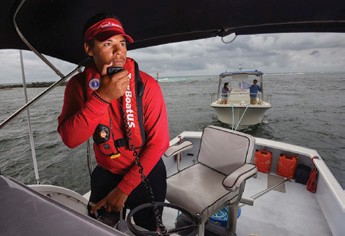 The U.S. Coast Guard recently issued a Marine Safety Alert indicating that LED (light emitting diode) lights may be causing poor VHF radio and Automatic Identification System (AIS) reception. The alert, issued for informational purposes, outlines reports received from mariners concerning radio frequency interference caused by LED lamps that “were found to create potential safety hazards.”
The U.S. Coast Guard recently issued a Marine Safety Alert indicating that LED (light emitting diode) lights may be causing poor VHF radio and Automatic Identification System (AIS) reception. The alert, issued for informational purposes, outlines reports received from mariners concerning radio frequency interference caused by LED lamps that “were found to create potential safety hazards.”
LED lights, popular with recreational boaters for their low battery draw, cooler operation and sturdy construction, may be causing poor VHF and AIS reception. © BoatUS.com
In some cases, the Coast Guard says, the interference may cause problems if mariners need to call for help. The interference can affect VHF voice communications as well as Digital Selective Calling (DSC) messages, and it may also affect AIS because they also use VHF radio. In particular, masthead LED navigation lights on sailboats may cause problems due to their close proximity to antennas. The Coast Guard advises boaters to test for the presence of LED interference by using the following procedures:
- Turn off LED light(s).
- Tune the VHF radio to a quiet channel (for example, channel 13).
- Adjust the radio’s squelch control until the radio outputs audio noise.
- Re-adjust the squelch control until the audio noise is quiet, only slightly above the noise threshold.
- Turn on the LED light(s).
If the radio now outputs audio noise, then the LED lights are causing interference and it’s likely that both VHF marine radio and AIS reception are being degraded. Potential solutions include contacting an electronics repair facility to address the problem, changing the LED bulb to incandescent bulb or fixture, or increasing the separation between the LED light and antenna.



